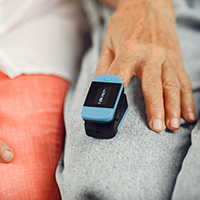Accuracy and precision of pulse oximeter at different sensor locations in patients with heart failure
Keywords:
Pulse oximeter, heart failure, accuracy, sensor, location, myocardial infarction, evaluationAbstract
Background: Despite its wide use in clinical practice, few studies had assessed the role of pulse oximetry in patients with heart failure. We aimed to evaluate the accuracy and precision of the pulse oximeter in patients with heart failure and to determine this accuracy at three different sensor locations.
Methods: Comparison of pulse oximetry reading (SpO2) with arterial oxygen saturation (SaO2) was reported in 3 groups of patients with heart failure (HF); those with ejection fraction (EF) >40%, those with EF <40%, and those with acute HF (AHF) with ST and non-ST segment elevation acute myocardial infarction (STEMI and non-STEMI).
Results: A total of 235 patients and 90 control subjects were enrolled. There were significant differences in O2 saturation between control and patients’ groups when O2 saturation is measured at the finger and toe, but not the ear probes; p=0.029, p=0.049, and 0.051, respectively. In HF with EF>40% and AHF with O2 saturations >90%, finger oximetry is the most accurate and reliable, while in HF with EF<40% and in patients with AHF with O2 saturations <90%, ear oximetry is the most accurate.
Conclusion: Pulse oximetry is a reliable tool in assessing oxygen saturation in patients with heart failure of different severity. In HF with EF>40% and in AHF with O2 saturations >90%, finger oximetry is the most accurate and reliable, while in HF with EF<40% and in patients with AHF with O2 saturations <90%, ear oximetry is the most accurate. Further studies are warranted.
References
DeMeulenaere S. Pulse Oximetry: Uses and Limitations. JNP 2007;3:312-7.
Hinkelbein J, Genzwuerker H, Fiedler F. Reliability and variability of oxygen saturation determined by pulse oximetry in intensive care patients. Anesthesiology 2003;99:A452.
Hinkelbein J, Hose D, Fiedler F. Comparison of three different sensor sites for pulse oximetry in critically ill patients. Int J Intensive Care 2005;12:159-63.
National Clinical Guideline Centre (UK). Acute heart failure: Diagnosing and managing acute heart failure in adults. London: National Institute for Health and Care Excellence; 2014.
Masip J, Gayà M, Páez J, Betbesé A, Vecilla F, Manresa R, et al. Pulse oximetry in the diagnosis of acute heart failure. Rev Esp Cardiol (Engl Ed) 2012;65:879-84.
Sepehrvand N, Alemayehu W, Rowe BH, McAlister FA, van Diepen S, Stickland M, et al. High vs. low oxygen therapy in patients with acute heart failure: HiLo-HF pilot trial. ESC Heart Fail 2019;6:667-77.
Bland JM, Altman DG. Statistical methods for assessing agreement between two methods of clinical measurement. Lancet 1986;1:307-10.
Brand T, Brand M, Jay G. Enamel nail polish does not interfere with pulse oximetry among normoxic volunteers. J Clin Monit Comput 2002;17:93-6.
Goldman JM, Petterson MT, Kopotic RJ, Barker SJ. Masimo signal extraction pulse oximetry. J Clin Monit Comput 2000;16:475-83.
Dumitru L, Baker MM. Heart failure. Medscape [Internet]. Available from https://emedicine.medscape.com/article/163062-workup#c11
Torres A Jr, Skender KM, Wohrley JD, Aldag CJ, Raff GW, Bysani GK, et al. Pulse oximetry in children with congenital heart disease: Effects of cardiopulmonary bypass and cyanosis. J Intensive Care Med 2004;19:229-34.
Schmitt HJ, Schuetz WH, Proeschel PA, Jaklin C. Accuracy of pulse oximetry in children with cyanotic congenital heart disease. J Cardiothorac Vasc Anesth 1993;7:61-5.
Clayton D, Webb RK, Ralston AC, Duthie D, Runciman WB. Pulse oximeter sensors: a comparison between finger, nose, ear, and forehead sensors under conditions of poor perfusion. Anaesthesia 1991;46:260-5.
Trivedi NS, Ghouri AF, Shah NK, Lai E, Barker SJ. Effects of motion, ambient light, and hypoperfusion on pulse oximeter function. J Clin Anesth 1997;9:179-83.
Zeballos RJ, Weisman IM. Reliability of noninvasive oximetry in black subjects during exercise and hypoxia. Am Rev Respir Dis 1991;144:1240-4.
Volgyesi GA, Kolesar R, Lerman J. An in vitro model for evaluating the accuracy of pulse oximeters. Can J Anaesth 1990;37:S67.
Kolesar R, Volgyesi G, Lerman J. Effect of haemoglobin concentration on the accuracy of pulse oximetry. Can J Anaesth 1990;37:S88.
Sedaghat-Yazdi F, Torres A Jr, Fortuna R, Geiss DM. Pulse oximeter accuracy and precision affected by sensor location in cyanotic children. Pediatr Crit Care Med 2008;9:393-7.
Das J, Aggarwal A, Aggarwal NK. Pulse oximeter accuracy and precision at five different sensor locations in infants and children with cyanotic heart disease. Indian J Anaesth 2010;54:531-4.

Published
Issue
Section
License
Mattioli 1885 has chosen to apply the Creative Commons Attribution NonCommercial 4.0 International License (CC BY-NC 4.0) to all manuscripts to be published.




